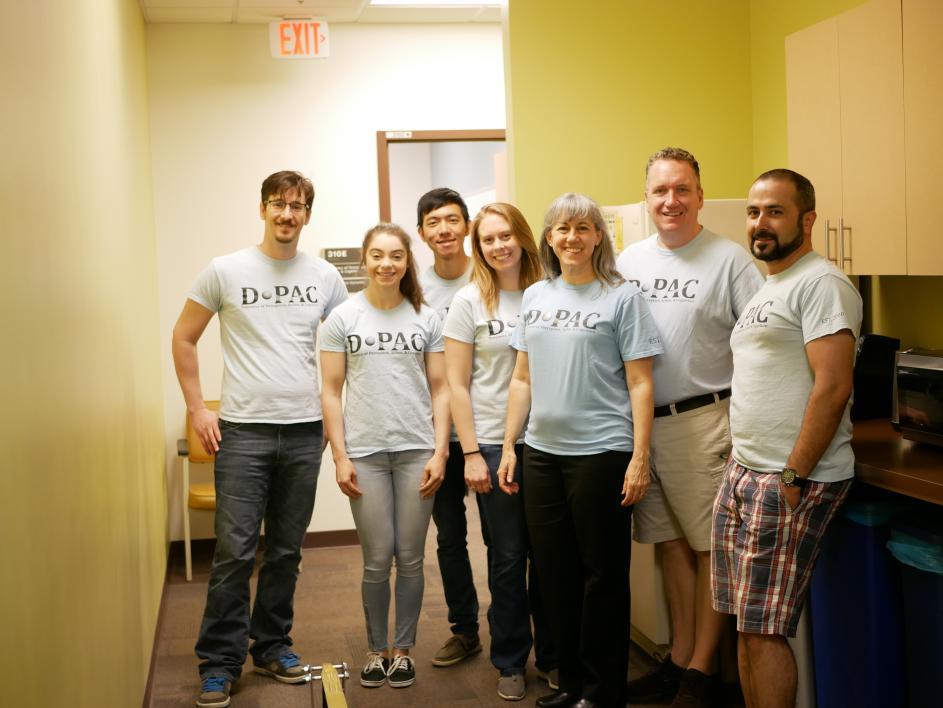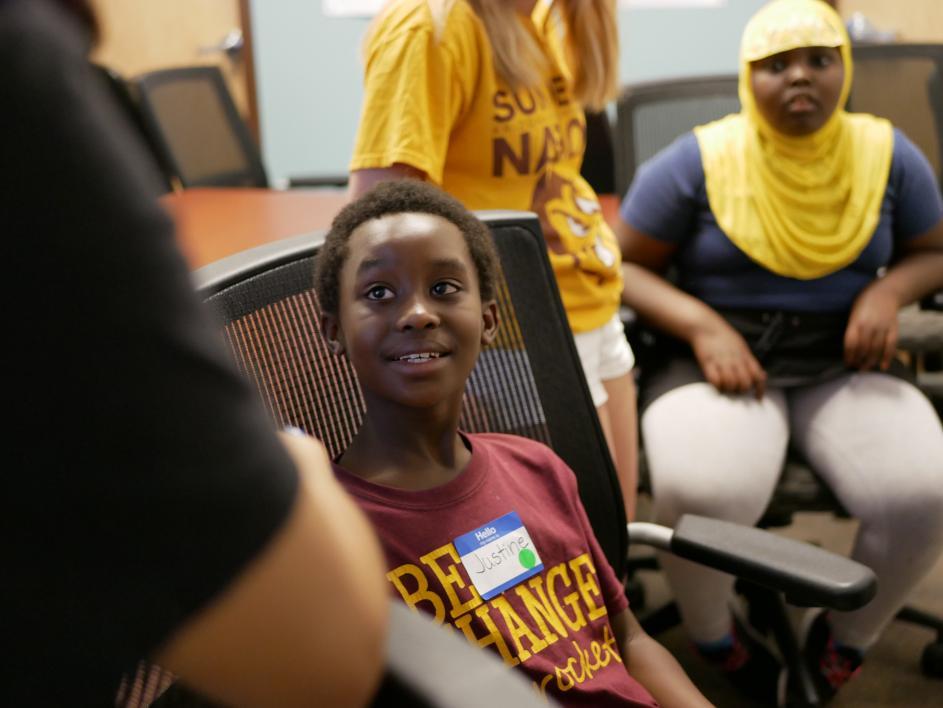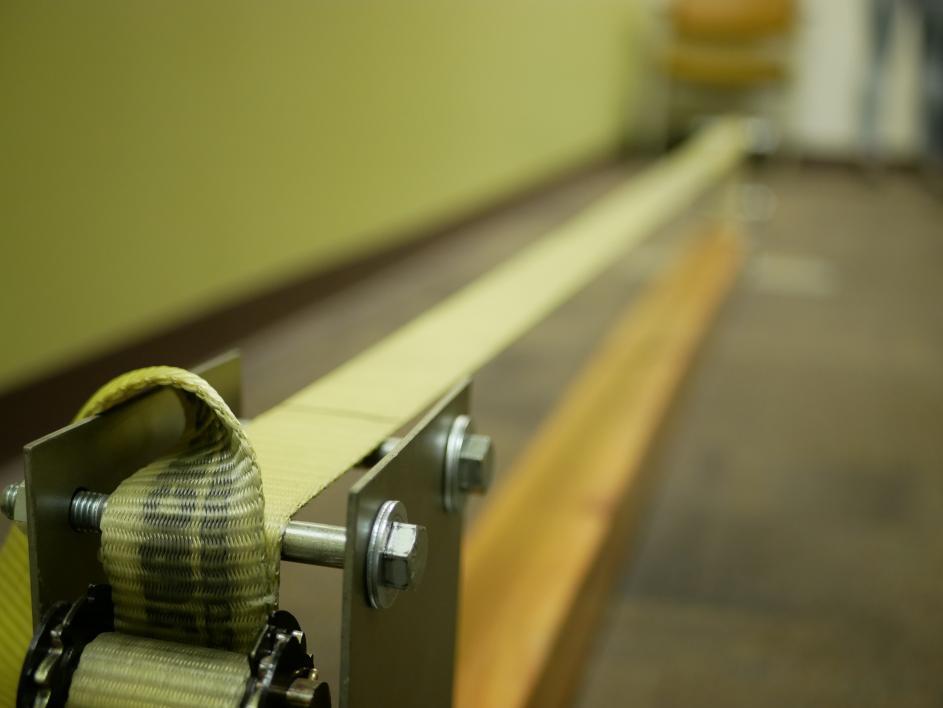Refugee students invited to experience a change of perception

Patricia Skains' class from Crockett Elementary School and the DPAC Lab.
The Dynamics of Perception, Action and Cognition Lab (DPAC) in the Arizona State University Department of Psychology recently hosted a special on-campus field trip for elementary school students. The lab spent the day teaching third- and fourth-grade refugee students about how people perceive and understand the world.
Nia and Eric Amazeen, associate professors of psychology and co-directors of the DPAC lab, partnered with Crockett Elementary School teacher Patricia Skains and ASU psychology undergraduate student Ashley Thompson.
When Thompson was a student in Nia Amazeen’s PSY 320 Learning and Motivation class, she noticed an opportunity to share a life-changing opportunity with the students that she tutors each week. Many of the students don’t have any opportunity to even leave their neighborhood, and Thompson decided to organize a trip to help shift their worldview.
“I really want to be the person that can show these kids what they can do and change the trajectory of what they perceive is possible in their own lives,” explained Thompson. “I want these students to see college as a reasonable goal and work to accomplish that goal.”
Skains’ class includes third- and fourth-grade students who are refugees from Somalia, Iraq, Pakistan, Congo, Rwanda, Mexico, Syria, Malaysia and South Africa. These students might have varied educational backgrounds, but all share an interest in science.
Crockett Elementary is part of the Balsz Elementary School District in Phoenix, and the students at the school come from all over the world. More than 17 languages are spoken in the halls, and the diversity of the student body is a source of pride.
“It is important to reach out to the community because some children do not have the opportunity to otherwise see what it is like to be a student at a university. Many of the kids on the field trip were shocked to hear that you can study virtually anything here at ASU,” said Morgan Waddell, a graduate student in the DPAC Lab. “We hope that showing young kids around the lab allows them to picture themselves earning a degree here and that visiting the lab shows them that it is possible to go to college and be successful in studying what they are interested in.”
The DPAC lab uses math to study behavior: how people perceive the world, how they act and move, and how they think. The research in the DPAC lab uses methods from mathematics and ecological psychology to try to understand how sensations such as vision and touch, people's movement, and attention and learning all work together to create human behavior.
The Crockett students participated in five experiments, including an experiment on proprioception, or how the brain understands where the body is in space. The students tested their proprioception with an experiment requiring different ways of balancing. They had to balance and walk along a slackline that was suspended above the ground; afterwards, they brainstormed how to improve their balance.
In the second experiment, students used a driving simulator to drive a racecar around a racetrack that was projected on a big screen. After the students became used to how the steering wheel worked, the wheel was reversed so that they had to move the wheel right to turn left. This experiment tests how quickly someone acclimates to drastic changes in the environment.
For the third experiment, the children watched how an electromyography device was used to measure muscle activity in Eric Amazeen’s arm as he flexed and lifted dumbbells. Waddell led them through a lesson on muscles of the body and how we use them to perceive weight.
Thanks to Crockett Elementary’s P.E. teacher and Arizona Teacher of the Year, Josh Meibos, the elementary students were well versed on their muscles because Meibos uses their individual languages as a method to break down cultural barriers and teach them about physiology.
“The kids had a lot of fun testing their driving skills in the coordination experiment and enjoyed showing off their knowledge of muscles and bones of the body in the muscle experiment,” Waddell said.
In the fourth experiment, students used different tools and their own bodies to measure the distance to near and far targets. They studied the relationship between height and arm span in a fifth experiment on correlation and compared their measurements to Phoenix Mercury star Brittney Griner.
The Amazeens said that the goal of the DPAC science day is to show young children that they can use science to learn more about things that interest them because science always starts and ends in the real world. They scale their lessons about the scientific method to the age of the students to teach them how to design experiments to answer their questions.
The public outreach events of the DPAC lab began more than nine years ago. The Amazeens estimated that the lab outreach has helped hundreds of students from challenged backgrounds understand what higher education is and that it is an attainable goal.
“We have been privileged to have the support of our families, teachers and community that helped get us to the position that we are in today. It’s our time to give back to the community by helping these children to fulfill their dreams,” said Eric Amazeen.
More Science and technology

Newly identified viruses found in dolphins
In a new study, researchers from Arizona State University together with national and international collaborators have identified…
ASU Interplanetary Lab celebrates 5 years of success
Five years ago, an Arizona State University student came up with the idea of creating a special satellite in what was then the…

ASU secures NSF grant to advance data science literacy as demand soars
In an era where data permeates every facet of our lives, the importance of data literacy cannot be overstated. Recognizing this…




